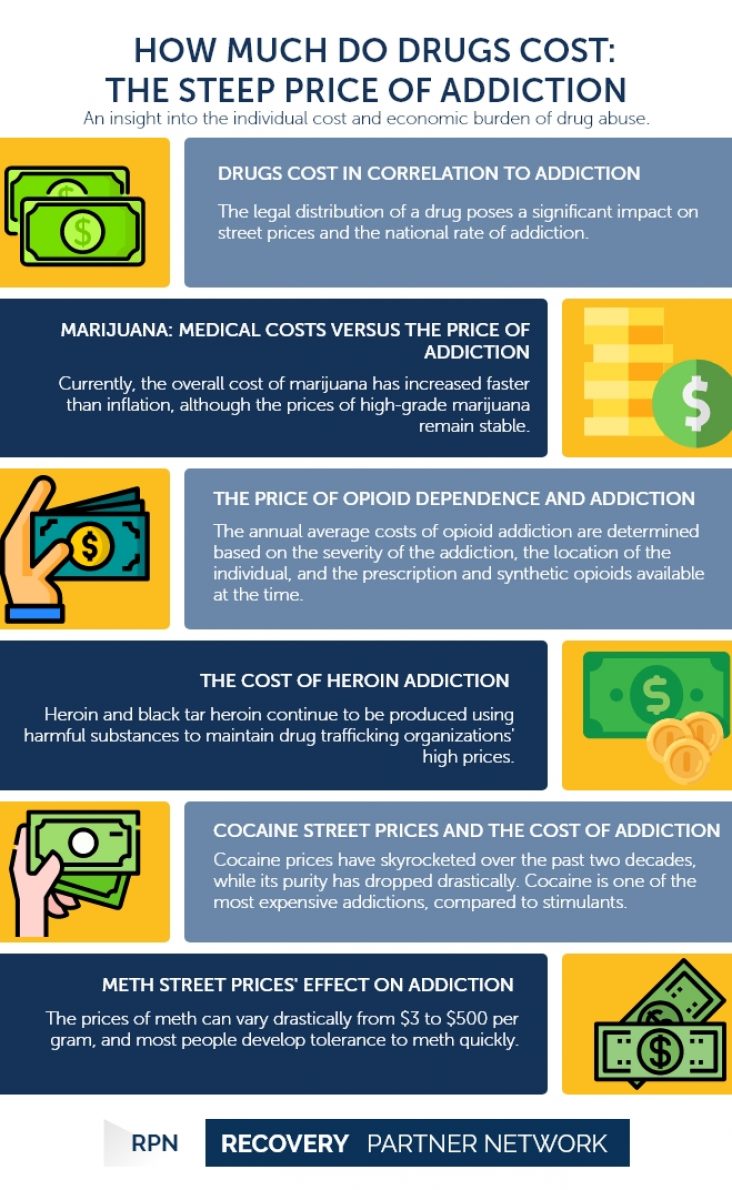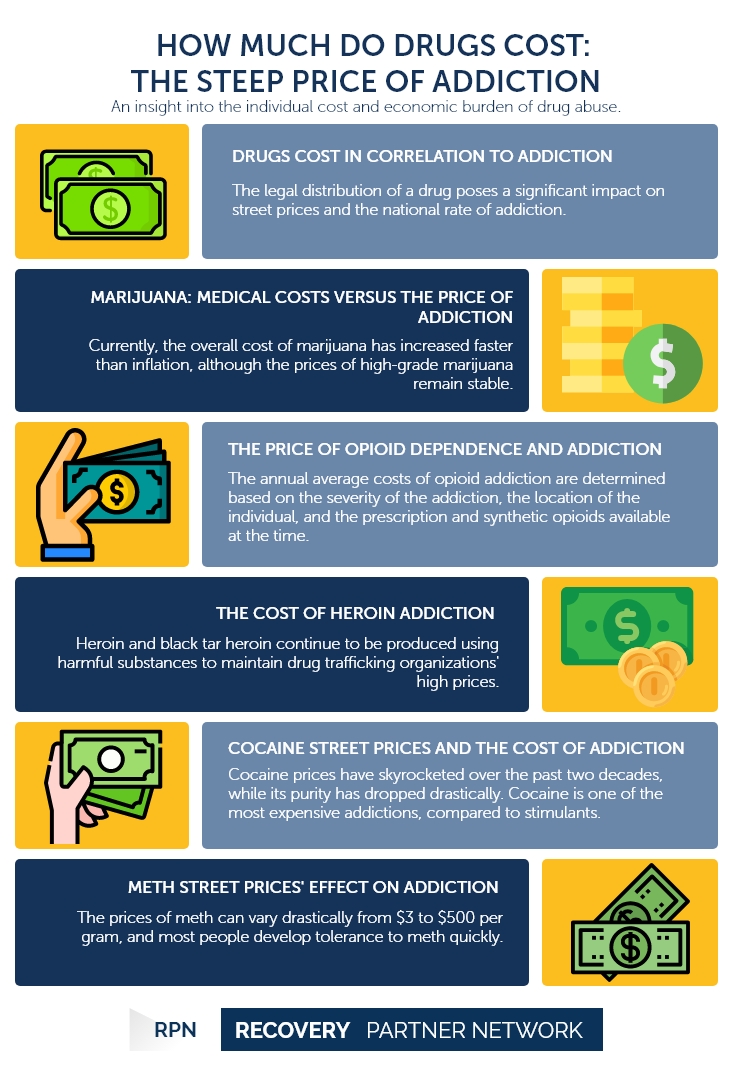An insight into the individual cost and economic burden of drug abuse.
How Much do Drugs Cost: The Steep Price of Addiction
How Much do Drugs Cost: The Steep Price of Addiction | Table of Contents
Drugs Cost in Correlation to Addiction
It has been estimated that around 700,000 Americans have died from a drug overdose between 1999 to 2017. Approximately three out of every four of these deaths (68 percent) had occurred due to opioids such as oxycodone and heroin. The National Institute on Drug Abuse (NIDA), the nation’s largest organization dedicated solely to addiction research, ascribes this drastic increase in deaths to the massive proliferation of prescription opioid painkillers in the 1990s and 2000s. At its highest rate of production in 2012, 81.3 opioid prescriptions were available for every 100 people. Just as it goes with all licit and illicit substances, the legal distribution of a drug poses a significant impact on the street prices and the national rate of addiction.
Provided below are the average prescription and street prices for marijuana and opioids and the usual cost of crack cocaine, cocaine, and meth per gram.
FAQ
- Why drug prices are so high?
- What drugs have increased in price?
- What is the most expensive drug in the world?
Drug prices are based on monopoly pricing. Drug prices are decided according to supply and demand, research costs, and by insurance industries, legislators, and pharmaceutical companies.
Prescription medications such as Eliquis, Jardiance, Spiriva, and Tradjenta have gone up 6%. Drugs such as Truvada, Chantix, Flovent, and Premarin have gone up between 3 to 5 percent.
Zolgensma is the world’s most expensive drug. Zolgensma is a gene therapy medication used to treat spinal muscular atrophy.
Marijuana: Medical Costs Versus the Price of Addiction
The legalization of marijuana in many states across the US for medical and recreational purposes has drastically increased its use and abuse. Although the potential to form a marijuana addiction is comparatively low compared to other addictive drugs, the possibility of developing a psychological dependence on it still remains.
In 1975, an article published by the New York Times addressed the soaring prices of marijuana as it became popular amongst the more affluent clientele. During this period, college students had to pay between $15 and $60 an ounce (approximately $71 and $285 today), while some high-grade ounces were sold as high as $350. Currently, the overall cost of marijuana has increased faster than inflation, although the prices of high-grade marijuana remain stable.
Individuals with a medical marijuana card will be expected to pay an average of $200 to $400 per ounce and $20 to $600 per gram.
Conversely, the street prices of weed, as marijuana is often called, tend to fluctuate across the country based on its supply, demand, and quality.
A brief summary of the average cost per ounce of marijuana by states:
| State | Low-grade price per ounce | High-grade price per ounce |
| Arkansas | $138.22 (Lowest state price) | $332.67 |
| California | $193.25 | $256.79 |
| D.C. | $377 | $595.87 (highest state price) |
| Florida | $169.39 | $298.70 |
| New York | $238.51 | $337.81 |
| Texas | $162.87 | $324.45 |
A study conducted on marijuana smoking practices (the most common form of marijuana ingestion) has found that blunts were the most popular, followed by joints and then pipes. Generally, a blunt holds 1.5 times more marijuana than a joint and 2.5 times more than a pipe. Consequently, those who smoke blunts are highly likely to ingest huge amounts of marijuana more frequently than someone who smokes it by other means. A further discovery shows that pipe users spend more money per gram of marijuana.
Approximately an average ounce of weed can generate 28 blunts, 42 joints, and 70 bowls for a pipe. For instance, if an individual smokes four joints per day, he/she would most likely spend around $4800 to $13,905 annually on marijuana alone.
The Price of Opioid Dependence and Addiction
Since opioids are a class of drugs that contain many substances, prices may vary widely. In 2017, 58.7 opioid prescriptions were available for every 100 people in the US. Most of these prescriptions were purchased through government-funded or private-funded insurance. What is more upsetting is that many insurance companies tend to place highly-addictive opioids such as long-acting morphine in the lowest-cost tiers, while the less-addictive alternatives remain comparatively expensive. 0.3 percent of the population has abused heroin in the past year, of which around 80 percent had previously abused prescription painkillers.
The annual average costs of opioid addiction are determined based on the severity of the addiction, the location of the individual, and the prescription and synthetic opioids available at the time. Since most individuals with opioid dependence mainly access the drugs through their doctors, insurance tends to inadvertently cover the costs. For example, Vicodin® (the brand name for acetaminophen/hydrocodone) costs about $126 for 100 pills (or $1.26 per tablet), while a single pill costs around $5 or $500 per bottle of 100 pills in the street. The high street prices, combined with its highly regulated nature, divert people into finding cheaper alternatives such as fentanyl and heroin.
The Price of Prescription Opioid Painkillers Compared to Street Values
| Prescription Opioid | Cost without insurance per pill | The street price per pill |
| Fentanyl patch (25mcg/hr) | $9.40 | $40 |
| Narco® (325mg/7.5mg) | $3.68 | $3 |
| Oxycodone (15mg) | $0.33 | $20 |
| OxyContin® (15mg) | $6.52 | $15 |
| Percocet® (10mg/325mg) | $24.54 | $10 |
| Suboxone® film (8mg/2mg) | $9.21 | $20 |
| Tramadol (50mg) | $0.62 | $2 |
Oxycodone prescription (one of the most common prescriptions) consumed three times a day may cost around $361.35 annually without insurance and $3,285 when purchased on the streets. However, since an addiction may require an individual to take more and more of the drug due to the gradual build-up of tolerance, the total cost of their addiction may increase considerably.
FAQ
The average cost of prescription medication in the U.S is $ 1,200 per year, and cancer drugs cost $ 10,000 a month.
The price of prescription medications is on the rise, even during the pandemic. Every year, pharmaceutical companies raise the price during January and July, and this year is no different.
The Cost of Heroin Addiction
Heroin prices continue to drop, while its potency levels continue to increase. However, heroin and black tar heroin continue to be produced using harmful substances to maintain the high prices of drug trafficking organizations. A “baggie” (a small, single-use bag) of heroin typically costs around $5 to $20. However, the United Nations Office on Drugs and Crime (UNODC) reported that in 2016, the average price of heroin in the US was $152 per gram (which can usually be divided into 20 small bags).
Individuals with a more severe addiction to heroin have confessed to purchasing 10 to 15 bags of the drug per day. Establishing this as a standard, an individual would probably spend around $438 to $1,750 per week and $22,810 to $91,250 annually on heroin depending on the street prices.
Cocaine Street Prices and the Cost of Addiction
Cocaine prices have skyrocketed over the past two decades, while its purity has dropped drastically. This occurred mainly due to the rigid import regulations imposed post – 9/11 that forced drug cartels to pursue other means of importing the drug into the US. The added risks and costs associated with these means have compelled cartels to dilute the drugs’ purity to enhance profits.
As per the World Drug Report, cocaine in the US costs around $25 to $200 per gram, with the typical prices falling at $112 per gram. In 2016, the average price of cocaine was $93, while its purity was also at a record-high in most parts of the world.
Generally, a gram of cocaine can be divided into ten lines or 25 “bumps” or “hits.” Although individuals abuse cocaine at different rates based on their addiction and tolerance to the substance, severe addicts generally consume around 5 grams per day. This level of cocaine addiction can cost around $169,725 per year. As a matter of fact, cocaine is regarded as one of the most expensive addictions, compared to stimulants such as crack and meth, which are generally produced at a cheaper cost.
Crack Cocaine Street Prices' Effect on Addiction
Crack cocaine, simply known as crack, is the crystallized version of cocaine. This form is less costly than cocaine due to its low purity and short-lasting highs. In 2004, the World Drug Report established $109 as the typical price for crack cocaine, although it could also be found at prices ranging between $18 to $200. A story by ‘Vice’ in 2016 identified the average cost of cocaine as $60 per gram, while the addiction costs around $225 per day in Canada. An individual with a crack cocaine addiction would spend around $82,125 annually on drugs.
Meth Street Prices' Effect on Addiction
Meth is a powerful stimulant that can release four times more dopamine than cocaine. Although “cooking” meth is a time-consuming and hazardous process, drug trafficking organizations generate more profits off of selling meth compared to other illicit drugs. Meth is mainly smuggled into the US from drug cartels from the south. Border patrols reportedly confiscate 10 to 20 times more meth compared to ten years ago.
Meth (often called crystal meth based on its formulation) is almost 100 percent pure. Since most people develop tolerance to meth in a considerably shorter period of time, much of rural America and the West are witnessing meth-related overdose deaths that are twice the rates of heroin-related fatal overdose.
The prices of meth can vary drastically from $3 to $500 per gram. Most hits cost about $5, and since a gram holds four hits, most grams cost between $20 and $60. Thus, an individual with a severe addiction to meth would spend around $12,775 to $38,325 annually on drugs. The low price point of meth as well its purity, has made meth the drug of choice even among chronic crack cocaine users.
The Value of Addiction Treatment
As per the National Institute on Drug Abuse (NIDA), drug addiction and substance abuse in the US poses an economic burden of more than $600 billion per year. The price of addiction, compared to the cost of addiction treatment (such as drug detox and inpatient and outpatient rehab), is much lower in the long-run. Addiction treatment also costs less compared to other measures taken to curb drug abuse. For instance, a year-long methadone prescription costs about $4,700 in comparison to the prison cost of $24,000 per individual.
“According to several conservative estimates, every dollar invested in addiction treatment programs yields a return of between $4 and $7 in reduced drug-related crime, criminal justice costs, and theft.”
– National Institute on Drug Abuse, “Is drug addiction treatment worth its cost?”, 2018
Recovery Partner Network
We aim to educate and empower. If you feel our library of resources does not cover your specific need, reach out to us, and we would be happy to help.
STATISTICS
© Copyright 2025


